Suzuki cross-coupling
- Last updated
- Save as PDF
- Page ID
- 15665
Suzuki-Miyaura coupling (or Suzuki coupling) is a metal catalyzed reaction, typically with Pd, between an alkenyl (vinyl), aryl, or alkynyl organoborane (boronic acid or boronic ester, or special cases with aryl trifluoroborane) and halide or triflate under basic conditions. This reaction is used to create carbon-carbon bonds to produce conjugated systems of alkenes, styrenes, or biaryl compounds (Scheme 1).

Scheme 1: General reaction scheme of Suzuki cross coupling reaction.
Modified conditions have demonstrated reactivity with less reactive substrates such as alkyl boranes (BR3) or aryl or alkenyl chlorides by amending the base and ligands employed.
References:
1. Chemler, S. R.; Trauner, D.; Danishefsky, S. J. Angew. Chem. Int. Ed., 2001, 40, 4544.
Historical Methods: Forming carbon-carbon bonds via cross coupling reactions
The Suzuki coupling is a pioneering reaction in cross coupling, and has been thoroughly studied since. The first Suzuki-type cross coupling reaction between phenylboronic acid and haloarenes was published by Suzuki and Miyaura in 1981 (Scheme 1).1 Commonly, Suzuki coupling is compared to Stille coupling seeing that boron has a similar electronegativity to tin, which is used for transmetallation in Stille coupling. Both couplings have a similar reaction scope and proceed via a similar mechanistic cycle.

Scheme 1: Suzuki cross coupling reaction of phenylboronic acid and haloarenes.
Stille cross coupling reactions can form carbon-carbon bonds between alkenyl (vinyl), aryl, or alkynyl halides and an extended scope of organotin alkynes, alkenes, aryl, allyl benzyl, ketones, and alkyl. However, Stille coupling poses several drawbacks seeing that organotin reagents are: (1) highly toxic, (2) costly, and have a (3) lower functional group tolerance, despite Suzuki coupling not being suitable for base sensitive substrates.2 The example below demonstrates that even under conditions for either a Stille or Suzuki coupling to ensue, primarily Suzuki coupling occurs (Scheme 2).3

Scheme 2: Suzuki versus Stille cross coupling reaction.
Negishi coupling also demonstrates similar transformations to Suzuki coupling in a comparable substrate scope. It uses organo-zinc for transmetallation. However, Negishi coupling tends to occur in lower yields, with less functional group tolerance, and is water and oxygen sensitive.1
References:
- Miyaura, N.; Yanagi, T.; Suzuki, A. Synth, Commun. 1981, 11, 513.
- Suzuki, A. Proc. Jpn. Acad., Ser. B., 2004, 80, 8, 359.
- Ishiyama, T.; Miyaura, N.; Suzuki, A. Synlett, 1991, 687.
Reaction Scheme
Suzuki coupling proceeds via three basic steps: oxidative addition, transmetallation, and reductive elimination.

Reaction Mechanism and Mechanistic Studies
The general catalytic cycle for Suzuki cross coupling involves three fundamental steps: oxidative addition, transmetalation, and reductive elimination as demonstrated in Figure 1.1 The oxidative addition of aryl halides to Pd(0) complex is the initial step to give intermediate 1, a Pd(II) species. Under the participation of base, an organoborane compound reacts with intermediate 1 in transmetalation to afford intermediate 2. This is followed by reductive elimination to give the desired product and regenerate the original Pd(0) species. Depending on different catalytic systems with various catalysts, ligands, and solvents, there are additional processes in the catalytic cycle, including ligand or solvent association and dissociation.2 Undoubtedly, these three fundamental steps occur since intermediates 1 and 2 have been characterized by isolation3 or spectroscopic analyses4.
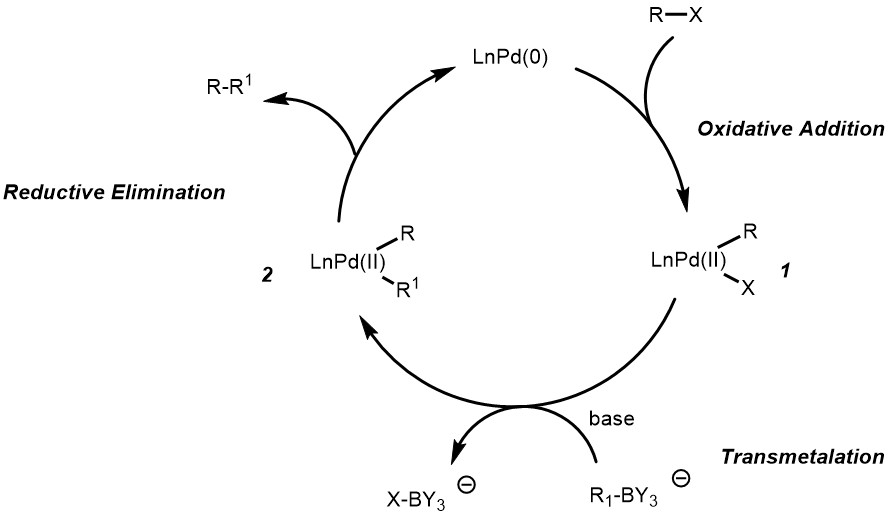
Oxidative addition is the rate determining step in the catalytic cycle and the relative reactivity decreases in the order of I > OTf > Br > Cl.4a The oxidative addition involving Pd(0) complexes is a SN2-type mechanism based on the unambiguous evidence of stereochemical inversion of configuration at alkyl halides carbon.5 Mechanistic studies have revealed that the apparently simple oxidative addition step consists of four concurrent isomerization pathways from the cis isomer, which is initially formed, to the more stable trans isomer (Figure 2).6

Transmetallation is initiated by base to encourage the transfer of the aryl or alkyl group from the organoborane to the Pd complex. The intermediates and stereochemistry of this step were determined by:
- Low-temperature rapid injection nuclear magnetic resonance (NMR) spectroscopy & kinetic studies have recently revealed three different species containing palladium-oxygen-boron linkages were identified and characterized as the pre-transmetalation intermediates.
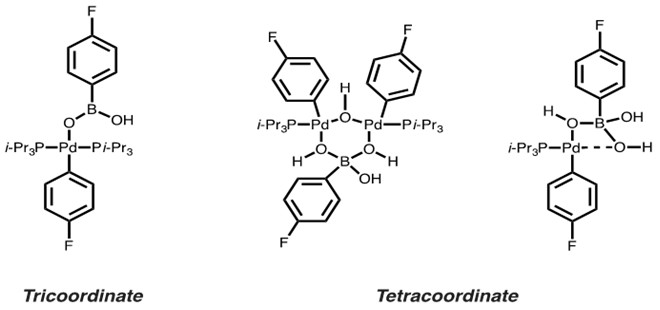
- Deuterium-labeling experiments demonstrated the retention of stereochemistry in the transmetalation step (Figure 4).8 Here, smaller J-values (approximately 0-7 Hz) correspond to a syn configuration, and larger J-values (8-15 Hz) corresponds to the anti configuration.
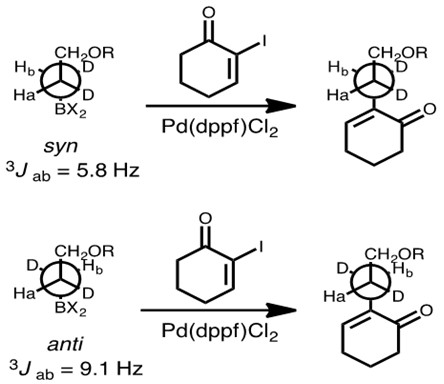
Reductive elimination occurs from the cis complex, therefore the trans complexes isomerizes to cis isomer to undergo reductive elimination.9 The elimination was confirmed to proceed intramolecularly from the cis isomer9 based on:
Kinetic studies showed that reductive elimination obeys first order kinetics, hence the rate and reaction is dependent only on the concentration of the post-transmetallation Pd-complex.
Deuterium labeling demonstrated no cross-coupling product from crossover between two Pd complexes (Figure 5).

References
- (1) Miyaura, N.; Suzuki, A. Chem. Rev., 1995, 95, 2457.
- (2) Barder, T. E.; Walker, S. D.; Martinelli, J. R.; Buchwald, S. L. J. Am. Chem. Soc. 2005, 127, 4685.
- (3) (a) Fitton, P.; Rick, E.A. J. Organomet. Chem. 1971, 28, 287.
- (b) Parshall, G. W. J. Am. Chem. Soc. 1974, 96, 2360.
- (4) Aliprantis, A. O.; Canary, J. W. J. Am. Chem. Soc. 1994, 116, 6985.
- (5) (a) Lau, K. S. Y.; Stille, J. K. Acc. Chem. Res.,1977, 10, 434.
- (b) Lau, K. S. Y.; Fries, R. W.; Stille, J. K. J. Am. Chem. Soc. 1974, 96, 5956.
- (6) Casado, A. L.; Espinet, P. Organometallics, 1998, 17, 954.
- (7) Thomas, A. A.; Denmark, S. E. Science, 2016, 352, 329.
- (8) Ridgway, B. H.; Woerpel, K. A. J. Org. Chem. 1998, 63, 458.
- (9) Gillie, A.; Stille, J. K. J. Am. Chem. Soc., 1980, 102, 4933.
Catalysts
Palladium catalysts are most widely employed in Suzuki coupling. Normally, the active Pd catalyst consist of two parts: precursors (for example: Pd(OAc)2, Pd2(dba)3, or Pd(PPh3)4) and ligands. To enhance the reactivity and stability of the catalyst, they were developed to be electron-rich and spatially bulky, which affords a high turnover number (TON) and low loading.1,2 For example, palladacycles (Figure 4) were developed and exhibit thermal stability, robust reaction times, insensitivity to air and water, low cost, and environmentally friendly.3,4

In terms of separation and recycling of the catalysts, people have developed polymer-supported heterogeneous catalysis systems for Suzuki coupling reaction.5 Polymer-supported heterogeneous catalysis have tremendous values in pharmaceutical and industrial synthesis due to the advantage of preventing contamination from the ligand residue in products, fast recovery, and the simple recycling of the catalysts
References
- (1) Beller, M.; Fischer, H.; Herrmann, W. A.; Ofele, K.; Brossmer, C. Angew. Chem. Int. Ed. 1995, 34, 1848.
- (2) (a) Welch, S. L.; Bedford, R. B. Chem. Commun., 2001, 129.
- (b) Bedford, R. B. et al. Chem. Eur. J. 2003, 9, 3216.
- (3) (a) Alonso, D. A.; Na ́jera, C.; Pacheco, M. C. J. Org. Chem. 2002, 67, 5588.
- (b) Botella, L.; Na ́jera, C. Angew. Chem. Int. Ed. 2002, 41, 179.
- (4) Navarro, O.; Kelly, R. A.; Nolan, S. P. J. Am. Chem. Soc. 2003, 125, 16194.
- (5) (a) Kim, J. H.; Kim, J. K.; Shokouhimehr, M.; Lee, Y. S. J. Org. Chem. 2005, 70, 6714.
- (b) Nishio, R.; Sugiura, M.; Kobayashi, S. Org. Lett., 2005, 7, 4831.
Suzuki Cross Coupling Reaction Ligand Design
Since the 1980’s, Suzuki reactions have been significantly improved, which lends to why the Suzuki reaction is so powerful: the elegant ligand design for Pd catalysts. Ligands are designed with electron-rich and spatially bulky features since electron-rich ligands can facilitate the oxidative addition step, and spatially bulky structures increase the orbital overlapping on the metal which enables reductive elimination.1 Based on which atom is coordinated with the metal, ligands are categorized as Phosphine ligands, Carbon ligands, or Nitrogen ligands.
Phosphine ligands are the most popular Pd ligands in both the laboratory and industry. PPh3 was the earliest and most widely use monodentate phosphine ligand2 in Suzuki reactions. Inspired by the structure of PPh3, scientists have manipulated substitutions on the phosphor atom and aromatic ring to tune the different reactivity of the reaction. For example, Fu and other research groups3 replaced aromatic groups with more electron-rich and bulkier alkyl groups (Figure 1), and the resulting ligands gave high catalytic reactivity on less reactive substrates with lower catalyst loading.

In the late 1990’s, Buchwald’s group introduced new electronic rich and bulky phosphine ligands based on the frame skeleton of dialkylbiaryl phosphine ligands4. Understanding the impact of substitutions on dialkylbiarylphosphines on the efficacy of catalytic reactions, the Buchwald group has synthesized a series of dialkylbiaryl ligands facilitating Palladium-catalyzed C-C, C-N, and C-O bond-forming processes, as well as supporting ligands for other reactions.4 There are other monodentate phosphine ligands with unique structures, which can also promote Suzuki reaction effectively, for example, monodentate ferrocene phosphine ligands.5

Many research groups have also designed and synthesized bidentate phosphine ligands (Figure 3) for the Suzuki reaction, and those ligands showed excellent reactivity on substrates that are generally challenging for monodentate ligands.

Carbon & Nitrogen ligands: Carbon ligands mainly comprise carbene8- and olefin9-type ligands for Suzuki couping. Efficient nitrogen ligands include amines and imines.9
References
- Miyaura, N.; Suzuki, A. Chem. Rev., 1995, 95, 2457.
- (a) Zhang, H.; Kwong, F. Y.; Tian, Y.; Chan, K. S. J. Org. Chem., 1998, 63, 6886.
(b) Sasaki, M.; Fuwa, H.; Ishkawa, M.; Tachibana, K. Org. Lett., 1999, 1, 1075.
(c) Kim, Y. M.; Yu, S. J. Am. Chem. Soc. 2003, 125, 1696.
(3) (a) Netherton, M. R.; Dia, C.; Neuschutz, K.; Fu, G. C. J. Am. Soc. Chem. 2001, 123, 10099.
(b) Dong, C. G.; Hu, Q. S. J. Am. Soc. Chem. 2005, 127, 10006.
(c) Monteith, M. J. Spec. Chem. Mag. 1998, 18, 436.
(d) Zapf, A.; Beller, M. Chem. Eur. J. 2000, 6, 1830.
(e) Zapf, A.; Ehrentraut, A.; Beller, M. Angew. Chem. Int. Ed. 2000, 39, 4153.
(f) Reider, P. et al Org. Lett. 2006, 78, 1787.
(4) Martin, R.; Buchwald, S. L. Acc. Chem. Res., 2008, 41, 1461.
(5) Liu, S. Y.; Choi, M. J.; Fu, G. C. Chem. Commun., 2001, 2408.
(6) (a) Kamatani, A.; Overman, E. J. Org. Chem. 1999, 64, 8743.
(b) De, D.; Krogstad, D. J. Org. Lett. 2000, 2, 879.
(c) Shen, W. Tetrahedron Lett. 1997, 38, 5575.
(d) Old, D. W.; Wolf, J. P.; Buchwald, S. L. J. Am. Soc. Chem. 1998, 120, 9722.
(7) Gstottmayr, C. W.; Bohm, V. P.; Herweck, E.; Grosche, M.; Herrmann, W. A. Angew. Chem. Int. Ed. 2002, 41, 1363.
(8) Kuwano, R.; Yokogi, M. Org. Lett. 2005, 7, 945.
(9) Tao, B.; Boykin, D. W. J. Org. Chem., 2004, 69, 4330.
Suzuki Cross Coupling Reaction Substrate Scope
Electrophilic Partners1: The electrophilic partners in Suzuki coupling are: alkenyl, alkynyl, allyl, benzyl, aryl, and alkyl halides or triflates. Aryl halides are activated by electron-withdrawing (EWD) groups in the ortho or para positions or 1-alkenyl halides with EWD groups in the alpha or beta positions. This increases their reactivity in oxidative addition compared to those with electron-donating groups. The order of reactivity of the electrophilic partners based on their leaving groups is:
I >> Br > OTf >> Cl > F
Chloride electrophiles are the most nonreactive as they are reluctant to participate in oxidative addition. Reactivity with chloride electrophiles has been established by using bulky, electron-donating (electron rich) phosphine ligands on the Pd catalyst and stronger bases to encourage dissociation of Cl.2
β- alkyl Suzuki coupling is most successful between hindered electron-rich organoboranes and electron-deficient vinyl or aryl halides or triflates. This counters the trends reported above in that the electrophilic partner would be activated by EWD groups.
Bases1: Transmetallation is initiated with base, and it’s reactivity varies with solvent.
Strong bases: NaOH, TlOH, and NaOMe perform optimally in THF or H2O solvent systems
Thallium bases such as TlOH, and its derivatives Tl2CO3 and TlOEt, enable cross coupling between alkyl boranes and alkyl halides. It also allows this reaction to proceed at lower temperatures (20 °C from the usual 50 to 80 °C). Unfortunately, these bases are air and light sensitive, but are still widely used.3
Weak bases: K2CO3 and K3PO4 perform optimally in DMF
Catalysts: Pd*, Ni, Ru, Fe, Cu
Palladium catalysts are the most widely used for Suzuki coupling and perform best with electron-donating (usually phosphine) ligands.
Nickel catalysts have been recently developed and demonstrate reactivity with inert electrophiles, especially chlorides and unreactive bromides. They have also expanded the electrophile scope to include: aryl fluorides (using a directing group, usually o-NO2), carbamates, sulfamates, esters, phosphate esters and ethers. This is enabled by nickel’s variation in oxidation states (Ni0 à Ni2+ and Ni+ à Ni3+) and increased nucleophilicity due to its small size. Use of Ni in catalysis is favored due to its abundance, and thus low cost.4
Boranes: Boronic acids, esters and tri-fluoro derivatives1,2
The reactivity of the borane to conduct transmetallation depends on its Lewis acidity. Therefore, EWD substituents increase the reactivity of the borane. The general trend of borane reactivity is:
ArBF3 > RB(OH)2 > RB(OR)2 >> R3B
Alkyl boranes are the least reactive, and rarely participate in transmetallation under standard conditions; however this has been amended with the use of stronger bases.
Selecting a borane for a reaction depends on its compatibility with its electrophile coupling partner and desired borane R group.
References:
- Chemler, S. R.; Trauner, D.; Danishefsky, S. J. Angew. Chem. Int. Ed. 2001, 40, 4544.
- Suzuki, A. Proc. Jpn. Acad., Ser. B. 2004, 80, 8, 359.
- Molander, G. A.; Biolatto, B. J. Org. Chem. 2003, 68, 4302.
- Han, F. S. Chem. Soc. Rev. 2013, 42, 5270.
Regio- and Stereoselectivity1,2
Each step of the catalytic cycle of Suzuki coupling can influence the regio- or stereo- configuration of the product. General rules of regio- and stereoselectivity relative to the substrates are:
Oxidative addition of alkyl and alkenyl halides retains the configuration of the electrophilic substrate, however allylic and benzylic halides invert this configuration. This step initially produces the cis complex which isomerizes to the trans complex.
Transmetallation and reductive elimination both retains the regio- and stereochemistry established in oxidative addition.
The borane substrate can also dictate selectivity of the cross coupling product. Often times the reactive borane species is formed in situ via hydroboration with 9-BBN. This occurs as a syn addition, and reductive elimination of the product retains the stereochemistry established by the hydroboration. However, reversing the order in which the reagents are added yields the anti addition product, which is also reflected in reductive elimination.
Chiral centers are formed by using chiral borane reagents. These reagents perform asymmetric cross coupling with retention of configuration i.e. (R) boranes yield (R) products, which follows suit for (S) boranes, in >90% enantiomeric excess.3
References:
- Suzuki, A. Proc. Jpn. Acad., Ser. B. 2004, 80, 8, 359.
- Chemler, S. R.; Trauner, D.; Danishefsky, S. J. Angew. Chem. Int. Ed. 2001, 40, 4544.
- Rybak, T.; Hall, D. G. J. Am. Chem. Soc. 2014, 136, 6534.
Advantages of Suzuki Coupling
Borane Substrates: Easy to synthesize, stabile, nontoxic, and cost effective1,2
The ease of synthesizing boranes provides convenient access to substrates for Suzuki coupling at a low cost and with minimal health risks. The two common methods to synthesize boronic acids are:
- React lithium or magnesium Grignard reagents with borate esters, followed by hydrolysis.

- React arylsilanes with boron tribromide, followed by acid hydrolysis.

Boronic esters are synthesized from boronic acids using alcohols or diols, especially pinicol.

Aryl trifluoroborates are synthesized by subjecting the corresponding alkyl boronic acid or ester to excess KHF2. Aryltrifluoroborates possess beneficial characteristics that allow for robust reactivity, easy purified, and reduced protodeboronation, which quenches the borane reagent.3

Reaction Conditions: Milder and Greener1,2,4
Typically, cross coupling reactions are run in organic conditions; however, Suzuki couplings can be performed in heterogeneous or purely aqueous conditions as organoboranes are water soluble and compatible with water soluble, inorganically supported, ligand-free Pd-catalysts. Boranes are exceptionally nucleophilic, and thus do not require extreme conditions for transmetallation which increases its functional group tolerance. Their high reactivity is also demonstrated in high turnover rates of the Pd catalyst used, which allows for a lower loading.
Organoboranes are nontoxic and stable to extreme heating and exposure to oxygen or water. Consequently, these reagents can be easily used at benchtop, and do not require special equipment or techniques, such as gloveboxes or air-sensitive and dry technique.1 This reaction has a high atom economy seeing that the byproducts are typically salts and water soluble borane byproducts.1.4 The lack of interfering byproducts allows for one-pot syntheses to further reduce waste and increase reaction efficiency.4 These attractive features of organoborane reagents increases its utility and synthetic convenience, and makes Suzuki coupling optimal for large scale and industry synthesis.
References:
- Suzuki, A. Proc. Jpn. Acad., Ser. B. 2004, 80, 8, 359.
- Chemler, S. R.; Trauner, D.; Danishefsky, S. J. Angew. Chem. Int. Ed. 2001, 40, 4544.
- Molander, G. A.; Biolatto, B. J. Org. Chem. 2003, 68, 4302.
- Paul, S.; Islam, M. M.; Islam, S. M. RSC Adv. 2015, 5, 42193.
Limitations of Suzuki Coupling:
Issues with reactants:
- Borane substrates commercially available do not encompass all R groups desired
- Borane substrates are generally preinstalled to more complicated substrates synthesized in lab, which is often difficult
- Some alkyl borates (sp3) and hetero- substrates don’t show reactivity1
- Chloride substrates react slowly, and with lower yields1
- Without base there are many side products1
Side reactions:
Beta-hydride elimination competes with reductive elimination, which affords a side product that greatly reduces the yield. This is observed with reactants that have beta-hydrides, most commonly alkyl substrates, but sometimes can be avoided by using Ni catalysts or ligands with larger bite angles.2
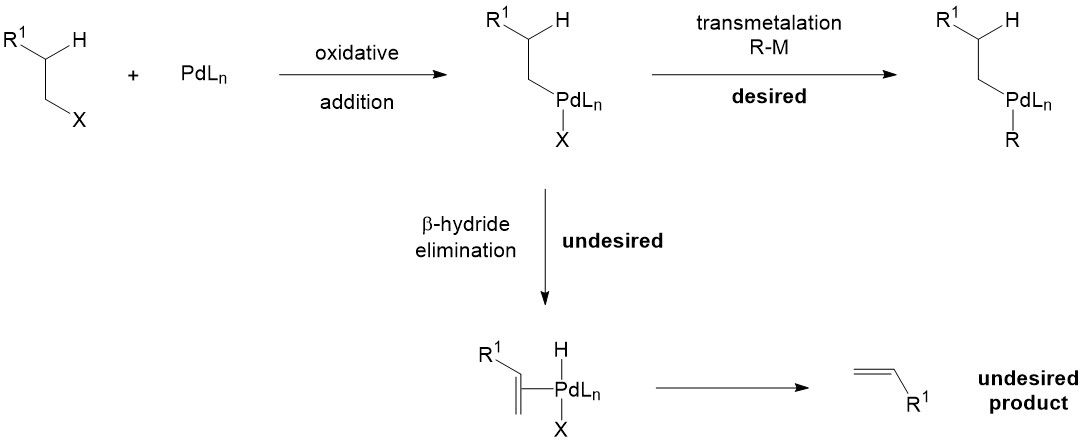
Scheme 1: Β-hydride elimination in Suzuki cross coupling reaction.2
References:
- Chemler, S. R.; Trauner, D.; Danishefsky, S. J. Angew. Chem. Int. Ed. 2001, 40, 4544.
- Netherton, M. R.; Dai, C.; Neuschutz, K.; Fu, G. C. J. Am. Chem. Soc. 2001, 123, 41.
Synthetic Applications:
Large-scale, industry synthesis of medicinal drugs1

Scheme 1: Suzuki cross coupling reaction to synthesize the drug Linifanib.
Linifanib (Scheme 1) is a tyrosine kinase inhibitor that was FDA approved as an anti-cancer drug that is synthesized on kilogram scale in the presence of different functional groups using Suzuki coupling for its industry production.
Natural products synthesis2
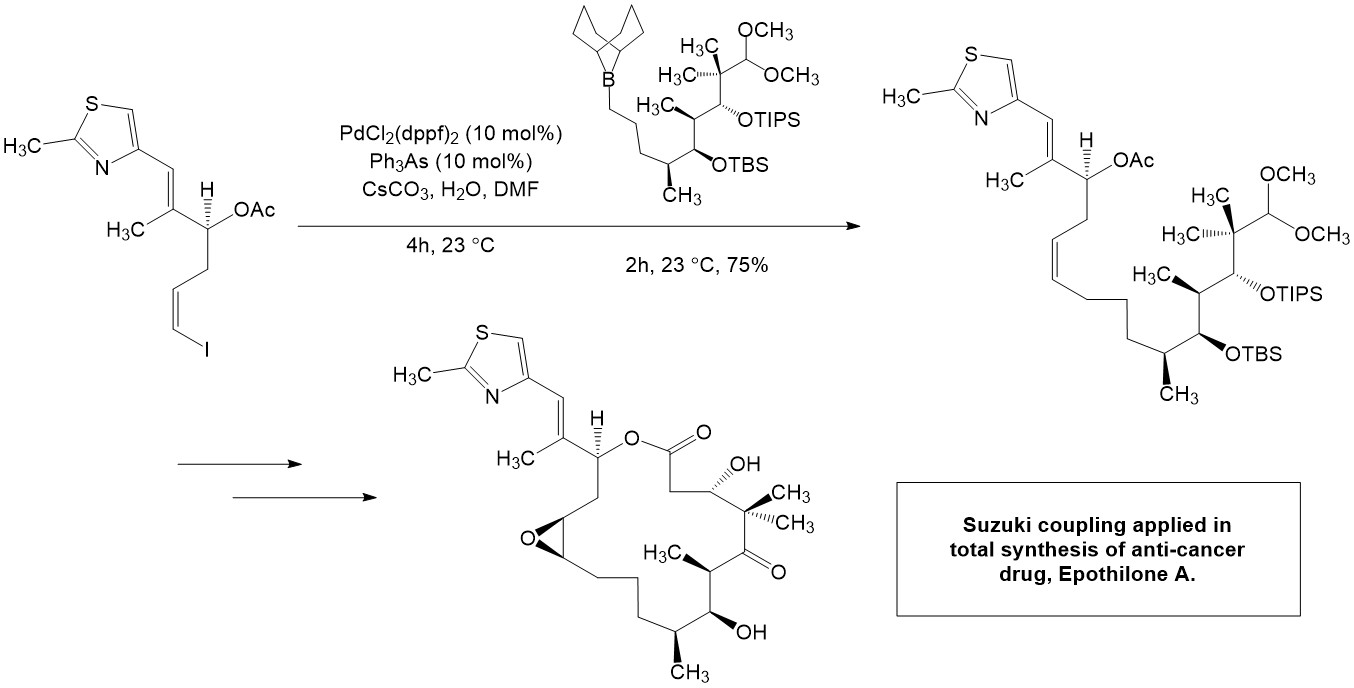
Scheme 2: Suzuki cross coupling reaction application: Epothilone total synthesis.
Suzuki coupling in the total synthesis of Epothilone A (Figure 2) was successful in the presence of numerous stereocenters and functional groups.
Polymer synthesis: Suzuki Polycondensation (SPC)3
Suzuki coupling has been applied to create polymers of aromatic groups, which yielded the longest conjugated chains. These polymers are categorized by their properties and applications:
(a) Polymers with alkyl or alkoxy chains and (c) Polyelectrolytes: SPC yields poly(p-phenylene)’s (PPP’s) which are used in LED lights
(b) Amphiphilic PPPs: SPC produces colloidal structures to create rechargeable, solid state lithium batteries
(d) PPP precursors for ladder polymers: currently being developed to apply their thermal, electrical, and optical properties to conducting materials, energy sources, and instrumentation
(e) Polymers with main-chain chirality and (f) Dendronized PPPs: used in organic synthesis of optically pure compounds
(g) Poly(arylene vinylene)’s and poly(arylene ethinylene)’s: Photoluminescence (PL) and electroluminescence (EL) characteristics for materials and instrumentation
(h) Various polymers: functionalization in synthesis via radical mechanism
References:
- Meng, D.; Bertinato, P.; Balog, A.; Su, D.; Kamenecka, T.; Sorensen, E. J.; Danishefsky, S., J. J. Am. Chem. Soc. 1997, 119, 10073.
- Kruger, A. W.; Rozema, M. J.; Chu-Kung, A.; Gandarilla, J.; Haight, A. R.; Kotecki, B. J.; Richter, S. M.; Schwartz, A. M.; Wang, Z. Org. Proc. Res. Dev. 2009, 13, 1419.
- Schluter, A. D. J. Polym. Sci. Part A: Polym. Chem. 2001, 39, 1533.
Contributors and Attributions
- Peiyuan Qu and Amanda Ramdular

